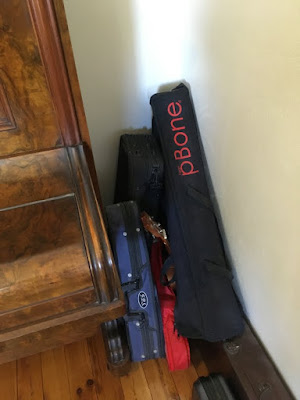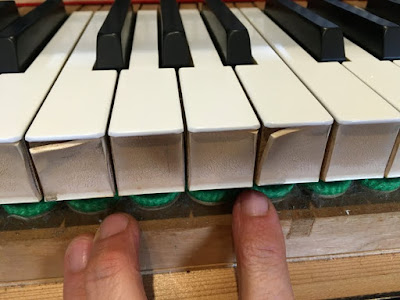A trombone (with slide extended to seventh position) might get the message across about physical distancing. I'll take it to every piano job, and to the supermarket.
"The only way we can control this is social distancing, the mathematical modelling is clear. Social distancing: not coming into contact with other people if you're infected. You not coming into contact with infected people and taking that risk. That is the only thing that works." - Dr Norman Swan - Coronacast 26 June 2020
Meanwhile: "Only last week, 3 metres was announced as the safest distance for woodwind and brass."*

"The only way we can control this is social distancing, the mathematical modelling is clear. Social distancing: not coming into contact with other people if you're infected. You not coming into contact with infected people and taking that risk. That is the only thing that works." - Dr Norman Swan - Coronacast 26 June 2020
Meanwhile: "Only last week, 3 metres was announced as the safest distance for woodwind and brass."*

Alternatively, for folk who may always have been space-invaders, this respectable piano with 88 keys and ample cheek blocks provides the perfect guide.
1.5 metres, with a handful of centimetres' extra safety margin.
It's settled. I'll take a decent Yamaha upright piano to every café. Actually this was one of myriad remarkable event tunings that filled my calendar pre-COVID. Surreal.
Ooh, a client has a trombone handy for me. Don't pan(dem)ic, I won't be wielding others' brass instruments. I googled to learn that this is a plastic trombone, but the slide stockings are metal. I have no plastic brass in my personal collection.
More art to contemplate, and a sticky-note arrow to indicate a problem key. During lockdown I met none of my scant number of domestic clients.
Ooh, an audience. These three-dimensional porcelain people were studied in great detail as I worked. I am a performer, but for the record (even pre-COVID) let it be known that no one needs folk pulling up chairs to attend a tuning. It's a service call, not a show. Please let your humble technician work in peace (or I'll pull out my trombone).
Beside the porcelain portraits, a shapely torso with a map of Europe. A body of land.
Watch your bulge area.
Rust, rust, rust. Such strings are weakened and roughened. They reach the stage where they become very difficult to persuade to move over the various bearing points in the piano. Yet many, many pianos we technicians service are in this situation. If your strings look like this they are ready to be replaced. But that is a major job. Until then, the best thing you can do is tune regularly enough that the tuning process is not always a massive catch-up of a really 'out' piano. Twice a year may see you sustain such strings for longer. Yearly tuning is the bare minimum. Then there is the question of the piano's environment and protection, which may be sub-optimum. When is rust OK? Never.
This light-wall feature (at a piano house) is the only time I've found rust to be almost beguiling.
Farm machinery sculptures and similar garden flotsam would be my only other concessions to a rusty aesthetic.

Anonymised client meeting Liberace. Impressive. I imagine they're discussing fingering. Piano fingering, people. Don't twist my words!

A beautiful light-filled house with great views (and still a sensible location for the piano). I arrive and execute pre-arranged solo entry protocol (during lockdown). At the time I didn't know that bears were a 'thing', to make children's local walks more fun.

Once I was hip, bear sightings enhanced my local walks (and they still do).

Such ridiculous pre-COVID opulence. I'd regularly tune (and stay, when on tour) in such stupidly swanky environs. This tree was enormous...

...and constructed entirely of teddies.

A mate spied this bear (pre-COVID) out on garbage night. If he lost some weight (the bear, not my mate) he could get a job in Paris, assisting with distancing...

...and vibing up a street café.
I've spent two days looking for photographs of a bear I saw while on a domestic tuning many years ago which dwarfed the 'bin night' bear. The client had warned me that there was a giant bear in the piano room. I wondered why she felt the need to mention such a detail... but when I saw the bear... it was three times as big as the piano!
Alas, the memory is all I have. The images cannot be found. My sister is my witness. She recalls me sending her the photos (and did her own search). Said Sis, "The bear WAS the room." It was seated in the corner of a kitchen across from the piano. Each leg spanned the the full length of the kitchen cabinetry.

If the bear had clogs... why will no one believe me? Except my sister. See how I kept my ears warm? I looped my scarf up over my head then back around my neck. Fine, as long as you don't have to look over your shoulder when riding a bicycle. I digress.

Marge admonishes Homer for reading the 'FOR FREE' column, full of junk. Homer: "Ooh, the Springfield Men's Shelter is giving away 60 soiled mattresses."

Then he spies this entry, fails to pronounce the word 'trampoline' successfully, and scarpers to score. Marge calls out, "Please don't bring home any more used crutches." I think of that line every time I see used crutches while out walking (using my two good legs). You'd be be surprised how many used crutches I have seen on my local walks. Buggered if I know who is discarding them.

This trampoline scene piques my interest. That's a piano keyframe, upside down.

I didn't touch any part of the pile. We can see the balance rail and front rail pins on which each piano key locates. I could have carried home some decent wood for a gardening project or bonfire, but I resisted. I already carry too many items home from hard rubbish piles (mostly garden pots).

Perhaps you can now recognise the keyframe in this piano. I present before and after cleaning the keyframe and keybed of a ballet school piano. So many hairpins and other trinkets treasured by hothoused tots. I bought a portable vacuum cleaner specially for this school's pianos.

It's 'easier' to dispose parts of a piano if you dismantle it. But the main and heaviest parts of a piano (strings, tuning pins, frame) should not be disassembled by a tinkerer. Lest one emulate Lenny in one of his many "Ow, my eye!" mishaps.

Elsewhere on the trampoline, another piano part. It's probably the upper part of the pedal assembly. Quality design, wood and woodwork can be found in the machinery of older pianos.

Keytops detaching (usually the whites) may be caused by age and exposure to excessive humidity fluctuations, old glue, the wrong glue, too little glue and certainly no preparation of the surfaces which will be glued. 21 keytops were off on this older (but not ancient) piano.

This new piano required all its 52 whites to be re-attached. There was a spate of such warranty issues. Folk can (and do) play, unaffected, on all sorts of scandalously out-of-tune pianos, but they really are hampered to the point of complaint when handfuls of key coverings dislodge on their new (el cheapo) pride and joy.

An older and more reputable instrument has curly dog-eared keyfronts. Plastic key coverings might be one part, or two. Ivory and older key coverings might have three parts.

The deformed and discoloured keyfronts can be tolerated, except where they have begun to interfere with the keyslip part (which I have removed). Notes were sticking down, and this was the cause. For now we'll judiciously sand and file to ensure clearance. The main offence was caused by the bottom edge of each key. I discovered after initially focusing on the more obvious curls. The position of the keyslip rail is also something that a piano technician may be able to subtly modify.

To replace all the curly keyfronts might be feasible. It is not a regular servicing assignment nor a regularly-available part. Ensuring that no keys stick down because of these warped parts will suffice.
The Caped Regulators did a piano repair job where all the keyfronts had fallen off. The client was convinced that a set of Scrabble tiles would provide the necessary parts. Fortunately we found almost all the detached keyfronts inside the piano, everywhere from under the pedals to under the keys. Quite the search. We had to provide about four keyfronts to complete the job.

Here's a not-Scrabble not-letter I found in a private piano. The all-seeing umlaut. The client is Belgian, but the umlaut is Swedish. We're through the looking glass here people."**
* "Only last week, 3 metres was announced as the safest distance for woodwind and brass." from The future of the arts: ‘The classical music world has been transfigured’ - The Guardian 21 June 2020
** "We're through the looking glass here people." - Milhouse Van Houten
This references a scene in the film JFK (1991) which itself is a reference to Through the Looking-Glass by Lewis Carroll (1871), the sequel to Alice's Adventures in Wonderland. It just means that if you uncover a conspiracy large enough as Milhouse believed he has, it is a whole new world where everything is different.
"The writers of the Simpsons are shockingly intelligent, and they aren't afraid to knock bodies down with it, so look out." - Source: An internet nerd
Browse more blogginess...
Pianos: Flat white, sharp white.
Pianos: Behind the Candelabra
Pianos: A mug's game (not really)
Pianos: Libraries, lemons and Lego.
Pianos: A bridge too far
Pianos: Nailed or screwed
Pianos: On the dot
LIST OF BLOG POSTS
















